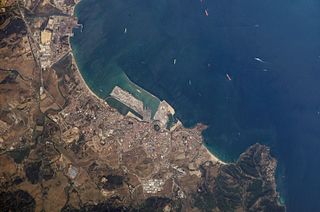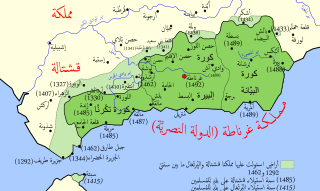Related Research Articles

Year 1309 (MCCCIX) was a common year starting on Wednesday of the Julian calendar.

Almogavars is the name of a class of light infantry soldier originated in the Crown of Aragon used in the later phases of the Reconquista, during the 13th and 14th centuries.

The Battle of Río Salado also known as the Battle of Tarifa was a battle of the armies of King Afonso IV of Portugal and King Alfonso XI of Castile against those of Sultan Abu al-Hasan 'Ali of the Marinid dynasty and Yusuf I of Granada.
Abu'l-Walid Ismail I ibn Faraj was the fifth Nasrid ruler of the Emirate of Granada on the Iberian Peninsula from 1314 to 1325. A grandson of Muhammad II on the side of his mother Fatima, he was the first of the lineage of sultans now known as the al-dawla al-isma'iliyya al-nasriyya. Historians characterise him as an effective ruler who improved the emirate's position with military victories during his reign.

Abu al-Hajjaj Yusuf ibn Ismail, known by the regnal name al-Muayyad billah, was the seventh Nasrid ruler of the Emirate of Granada on the Iberian Peninsula. The third son of Ismail I, he was Sultan between 1333 and 1354, after his brother Muhammad IV was assassinated.
Abu Abdullah Muhammad ibn Ismail, known as Muhammad IV, was the ruler of the Emirate of Granada on the Iberian Peninsula from 1325 to 1333. He was the sixth sultan of the Nasrid dynasty, succeeding to the throne at ten years old when his father, Ismail I, was assassinated.

The Emirate of Granada, also known as the Nasrid Kingdom of Granada, was an Islamic polity in the southern Iberian Peninsula during the Late Middle Ages, ruled by the Nasrid dynasty. It was the last independent Muslim state in Western Europe.
The Battle of Barcelona was a naval engagement fought in the coastal region of Barcelona, Catalonia, Spain, between the navies of the Crowns of Aragon and Castile, during the War of the Two Peters. A number of months beforehand, a large Castilian fleet had been assembled at Seville by order of the King of Castile, Peter I. Consisting of 128 warships including royal vessels, ships from the King of Castile's vassals, and several others that had been sent by the Castilian-allied monarchs of Portugal and Granada, this large fleet had been entrusted to the Genoese admiral, Egidio Boccanegra, who was seconded by two of his relatives, Ambrogio and Bartolome.

Joan Gilabert Jofré (1364–1417), also known as Padre Jofré or Pare Jofré, was a member of the Christian religious Order of Mercy and the founder of what is claimed to be the first psychiatric care institution in Europe, in Valencia, Crown of Aragon, in medieval Spain.
Alfonso Fernández el Niño was a Spanish nobleman, the illegitimate son of King Alfonso X of Castile and Elvira Rodríguez de Villada. He was the lord of Molina and Mesa through his marriage to Blanca Alfonso de Molina, daughter of the infante Alfonso of Molina and niece of King Alfonso IX of León.

The Battle of the Puig of 1237, also known as the Battle of the Puig de Santa Maria, the Battle of the Puig de Enesa, or the Battle of the Puig de Cepolla was a battle of the Iberian Reconquista and of the Aragonese Conquest of Valencia.

The siege of Algeciras was a battle of the Spanish Reconquista that occurred between July 1309 and January 1310. The battle was fought between the forces of the Kingdom of Castile, commanded by King Ferdinand IV of Castile and his vassals, and the Emirate of Granada commanded by Sultan Abu'l-Juyush Nasr. The battle resulted in a humiliating defeat for the Kingdom of Castile whose army was obliged to lift the siege due to the atrocious conditions of life in the Castilian camp and the desertion of Infante John of Castile. The battle marked one of the many battles fought at Algeciras where the Christian forces would try to take the city unsuccessfully from the Muslims.

The siege of Algeciras (1342–1344) was undertaken during the Reconquest of Spain by the Castillian forces of Alfonso XI assisted by the fleets of the Kingdom of Aragon and the Republic of Genoa. The objective was to capture the Muslim city of Al-Jazeera Al-Khadra, called Algeciras by Christians. The city was the capital and the main port of the European territory of the Marinid Empire.

The siege of Algeciras (1369) was undertaken during the period of the Reconquest of Spain by Muhammad V, the Emir of Granada to reclaim the city of Al-Hadra Al-Yazirat, called Algeciras by the Christians, in the Kingdom of Castile. The siege lasted just three days, and the sultan was victorious. The Muslims thus regained a major city which had been in Castilian hands since Alfonso XI of Castile took it from the Moroccans after the long 1342–1344 siege. Ten years after the capture of the city, in 1379 the sultan of Granada decided to completely destroy the city to prevent it falling into Christian hands. It was impossible to defend the place at a time when the Muslim kings of the Iberian Peninsula had lost much of military power they enjoyed in earlier centuries.

The 1487 siege of Málaga was an action during the Reconquest of Spain in which the Catholic Monarchs of Spain conquered the city of Mālaqa from the Emirate of Granada. The siege lasted about four months. It was the first conflict in which ambulances, or dedicated vehicles for the purpose of carrying injured persons, were used. Geopolitically, the loss of the emirate's second largest city—after Granada itself—and its most important port was a major loss for Granada. Most of the surviving population of the city were enslaved or put to death by the conquerors.

The Battle of Martos was a minor battle of the Spanish Reconquista fought between Martos and Torredonjimeno in Andalusia in 1275. The battle was fought between the troops of the Kingdom of Granada and those of the Crown of Castile. The Castilian force was completely destroyed as a result of the battle. There is some confusion in the dates since different authors report different dates. Zurita, for example, reports that the events described here took place between May and August; the more modern authors, however, put them between September and October.
The siege of Almería was an unsuccessful attempt by Aragon to capture the city of Almería from the Emirate of Granada in 1309. Almería, a Mediterranean port in the southeast of the emirate, was the initial Aragonese target in a joint Aragonese-Castilian campaign aimed at conquering Granada. The Aragonese troops led by their King James II arrived on 11 August, blockading the city and employing siege engines. The city, led by governor Abu Maydan Shuayb and naval commander Abu al-Hasan al-Randahi, prepared for the siege by strengthening its defenses and stockpiling food. Throughout the siege, both sides exchanged shots from siege engines and engaged in fields battles and skirmishes with varying results. James ordered multiple unsuccessful assaults. A Granadan relief column under Uthman ibn Abi al-Ula arrived nearby in September and harassed the besiegers.

The Battle of Ceuta (1339) was one of the battles of the Battle of the Strait.
The siege of Elche of 1332 was one of the battles of the Battle of the Strait.
References
- 1 2 Ferrer p. 128
- 1 2 3 Ferrer p. 129
- ↑ Rovira i Virgili p. 290
- ↑ Juan Mariana (1848). Historia general de España (in Spanish). Juan de Mariana. p. 152.
- ↑ Rovira i Virgili p. 292
- ↑ Ferrer p. 127
- 1 2 Jerónimo Zurita. Annals of the Crown of Aragon.
- ↑ Ferrer p. 133-134
- ↑ Jerónimo Zurita. Annals of the Crown of Aragon (PDF) (in Spanish). p. 18.